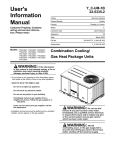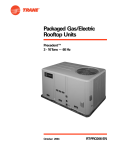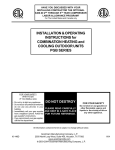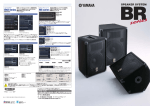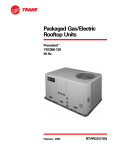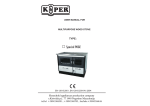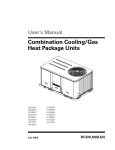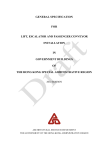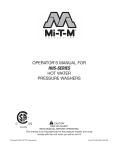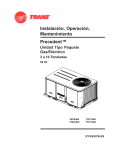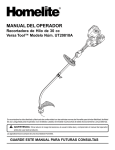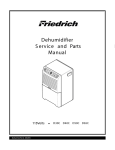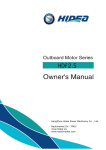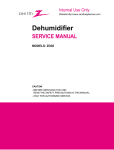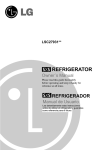Download (2) 508x635x25 (2
Transcript
User's Information Manual Customer Property: Contains wiring and service information. Please retain RT-SVU03A-EN Library Service Literature Product Section Unitary Product Rooftop Lt. Comm. Model Y_ Literature Type User's Manual Sequence A Date File No. December 2005 SV-UN-RT-SVU03A-EN 12/05 Supersedes Y_C-UM-1 01/01 YSC036E*, YHC033A*,YHC036A* Combination Cooling/ YSC060E*, YHC063A*, YHC060A* YSC072A*, YHC072A* YSC090A*, YSC092A*, YHC092A*, YSC102A*, YHC102A*, YSC120A*, YHC120A* Gas Heat Package Units Models : YSC048E*, YHC043A*,YHC048A* WARNING Hazard of Explosion or Fire! General Information Overview Your combination gas heating/electric cooling unit is designed to comfort condition all year long with safe, efficient, trouble free operation. It is important that you understand how to operate and maintain your unit to keep it operating safely and efficiently. This manual will acquaint you with these important procedures. Familiarize yourself with this manual and store it in a convenient location for future reference. Do not store or use gasoline or other flammable vapors and liquids in the vicinity of this or any other appliance. WHAT TO DO IF YOU SMELL GAS -Do not try to light any appliance. -Do not touch any electrical switch. -Do not use any phone in your building. -Open windows and doors. -Alert others and evacuate building immediately. -From a phone outsided of the building, immediately call your gas supplier. Follow the gas supplier's instructions. -If you can not reach your gas supplier, call the fire department. Failure to follow the steps listed above could result in death or serious injury or property damage. Any additions, changes or conversions required in order for the unit to satisfactorily meet the application needs should be made by a qualified product distributor or local service dealer, using factory specified and approved parts. See figure 1 for component layout. WARNING – Indicates a potentially hazardous situation which, if not avoided, could result in death or serious injury. WARNING Safety Hazard! CAUTION – Indicates a potentially hazardous situation which, if not avoided, may result in minor or moderate injury. It may also be used to alert against unsafe practices. Do not use this furnace if any portion has been under water. Immediately call a qualified service technican to inspect the furnace and to replace any part or the control system and any gas control which has been under water. Unito or component damage due to water could cause unit malcuntion resulting in death or serious injury or equipment or property damage. CAUTION – Indicates a situation that may result in equipment or property-damage-only accidents. WARNING Safety Hazard! Should overheating occur, or the unit gas valve fail to shut off, close the gas valve to the furnace before shutting off the electrical supply. Failure to close off the gas supply could result in death or serious injury or severe equipment or property damage. 2 IMPORTANT: Remember these instructions at all times: 1. Never perform any maintenance procedures until the electrical power to the unit is turned off. 2. Never perform any maintenance procedures until the gas valve is the gas supply line is turned off. 3. Never remove any panels from the unit while it is operating. 4. Never remove panels or parts from the unit that are not discussed in this manual. 5. Never cover the unit since it is designed to operate year round. Your unit is of complex design. To ensure that it performs safely and gives long lasting services, some of the maintenance work must be performed by a qualified service person. When a service person is referred to in this manual it is describing a service technician that has had special training or a number of years experience in servicing this type of equipment. It is your responsibility to select a qualified service company that can provide a service person of this caliber. the heating or cooling circuit to maintain the temperature setting you select. Many thermostats contain a room thermometer to indicate the approximate room temperature and a temperature scale at the adjustment indicator to select the desired indoor air temperature. In addition, most thermostats have a selector mode switch with Heat, Off and Cool positions and a fan switch with On and Off positions. When the switch is positioned at Off your unit will not operate in either the heat or cool modes. If the selector switch is set at Heat the unit will automatically cycle on and off to maintain the desired temperature setting. The unit will also operate automatically when the selector switch is positioned at Cool. The fan selector switch can be used to operate the indoor fan continuously by positioning it at On. When set to Auto the fan will only operate when required during the heating or cooling cycles. To ensure that the thermostat operates properly, it must be level and positioned to avoid the influence of such external heat sources and lamps, televisions or other heat producing appliances. Air Filters Filters are to be used with this unit. Units ship from the factory with filters installed. Thermostat Room thermostats are delicate temperature sensing controls. Their main function is to energize and de-energize 3 WARNING Hazardous Voltage w/Capacitors! Heating System Heating Cycle Operation Your unit's heating system has a solid-state electronic ignition control that lights the furnace burners each time the thermostat calls for heat. At the end of each heating cycle the furnace burners are extinguished. This type of system is called Direct Spark Ignition (DSI). Disconnect all electric power, including remote disconnects and discharge all motor start/run capacitors before servicing. Follow proper lockout/ tagout procedures to ensure the power cannot be inadvertently energized. Verify with an appropriate voltmeter that all capacitors have discharged. Failure to disconnect power and discharge capacitors before servicing could result in death or serious injury. A normal heating cycle begins when the air temperature drops below the thermostat setting. The thermostat then energizes the heating electrical circuit that starts and controls the furnace burners. Shortly after the burners ignite the indoor fan starts and circulates warm air through the conditioned space. It is very important to keep the central duct system air filters clean. Be sure to inspect them at least once each month when the systemis in constant operaton. (In new homes, check the filters every week for the first 4 weeks.) See Table 1 for the required filter size(s). When the air temperature rises to the thermostat setting the thermostat de-energizes the heating electrical circuit, which in turn extinguishes the burners. The indoor fan continues to circulate warm air until most of the heat is removed from the unit's combustion chamber. If you have disposable type filters, replace them with new filters of the same type and size Do not attempt to clean disposable filters. Safety Controls Your unit is equipped with an automatic reset safety limit control to prevent overheating. When this control opens, it shuts down the heating electrical circuit until the unit cools down sufficiently. Inadequate airflow (i.e., caused by dirty filters or defective fan motor) may cause the unit to cycle on and off as the limit trips and automatically resets. If you suspect that the unit is cycling on it's limit control, immediately contact a service person for instructions. Permanent type filters can be cleaned by washing them with a mild detergent and water. Ensure that the filters are thoroughly dry before reinstalling them in the unit (or duct system). Note: It may be necessary to replace permanent filters annually if washing fails to clean the filter, or to use the same type and sizeas was originally installed. If flames from the burner are not properly drawn into the heat exchanger, a Flame Rollout Protection Control will open causing the furnace to shut off. The cause must be investigated by a qualified service person. Table 1- Recommended Standard Filters Unit Model Number Low Heat Filter Size Inches Millimeters YHC033* (2) 20x25x1 (2) 508x635x25 YH/YSC036* (2) 20x25x1 (2) 508x635x25 YHC043* (2) 20x25x1 (2) 508x635x25 YH/YSC048* (2) 20x25x1 (2) 508x635x25 YSC060A1,3,4,W (2) 20x25x1 (2) 508x635x25 YHC060A1,3,4,W (2) 20x30x1 (2) 508x762x25 YHC063* (2) 20x30x1 (2) 508x762x25 YSC060*D,T (2) 20x30x1 (2) 508x762x25 YH/YSC072* (4) 16x25x2 (4) 406x635x50 YSC090* (4) 16x25x2 (4) 406x635x50 YSC092* (4) 16x25x2 (4) 406x635x50 YHC092* (4) 20x25x2 (4) 508x635x50 YH/YSC102* (4) 20x25x2 (4) 508x635x50 YH/YSC120* (4) 20x25x2 (4) 508x635x50 Medium Heat Filter Size Inches Millimeters (2) 20x25x1 (2) 508x635x25 (2) 20x25x1 (2) 508x635x25 (2) 20x25x1 (2) 508x635x25 (2) 20x25x1 (2) 508x635x25 (2) 20x25x1 (2) 508x635x25 (2) 20x30x1 (2) 508x762x25 (2) 20x30x1 (2) 508x762x25 N/A N/A (4) 16x25x2 (4) 406x635x50 (4) 16x25x2 (4) 406x635x50 (4) 16x25x2 (4) 406x635x50 (4) 20x25x2 (4) 508x635x50 (4) 20x25x2 (4) 508x635x50 (4) 20x25x2 (4) 508x635x50 4 High Heat Filter Size Inches Millimeters (2) 20x30x1 (2) 508x762x25 (2) 20x30x1 (2) 508x762x25 (2) 20x30x1 (2) 508x762x25 (2) 20x30x1 (2) 508x762x25 (2) 20x30x1 (2) 508x762x25 (2) 20x30x1 (2) 508x762x25 (2) 20x30x1 (2) 508x762x25 (2) 20x30x1 (2) 508x762x25 (4) 16x25x2 (4) 406x635x50 (4) 16x25x2 (4) 406x635x50 (4) 16x25x2 (4) 406x635x50 (4) 20x25x2 (4) 508x635x50 (4) 20x25x2 (4) 508x635x50 (4) 20x25x2 (4) 508x635x50 Heating System Start-Up Since your unit has an automatic ignition system, it is easy to start the heating cycle at the beginning of the heating season. In order for the unit to operate properly and safely, the furnace needs air for both combustion and ventilation. Check to make sure that all air openings are unobstructed and there is adequate clearance around the unit to provide good air flow. 1. Set the thermostat's heating adjustment lever at its lowest setting. 2. Move the selector switch to the Off position. WARNING Hazardous Voltage w/Capacitors! Disconnect all electric power, including remote disconnects and discharge all motor start/run capacitors before servicing. Follow proper lockout/ tagout procedures to ensure the power cannot be inadvertently energized. Verify with an appropriate voltmeter that all capacitors have discharged. Failure to disconnect power and discharge capacitors before servicing could result in death or serious injury. 3. Turn off all electric power to the unit. 4. This unit is equipped with an ignition device which automatically lights the burners. Important : The unit is to be adjusted to obtain an air rise within that specified on the nameplate. Heating System Shutdown To shut down the heating system for brief periods of time simply adjust the thermostat selector switch to the "Off" position. To Turn Off Gas To Unit 1. Set the thermostat to lowest setting. WARNING Hazardous Voltage w/Capacitors! Disconnect all electric power, including remote disconnects and discharge all motor start/run capacitors before servicing. Follow proper lockout/ tagout procedures to ensure the power cannot be inadvertently energized. Verify with an appropriate voltmeter that all capacitors have discharged. Failure to disconnect power and discharge capacitors before servicing could result in death or serious injury. 2. Turn off all electric power to the unit if service is to be performed. 3. Remove the access panel that contains the following label: REMOVE THIS PANEL TO GAIN ACCESS TO THE GAS VALVE Caution : Never attempt to manually light the burner. 5. Remove the access panel that contains the following label. REMOVE THIS PANEL TO GAIN ACCESS TO THE GAS VALVE 4. Turn gas control knob clockwise to the "OFF" position. 5. Replace panel removed in step 3 above. 6. Turn gas control knob clockwise to the "OFF position. Note: Some valves require the knob to be pushed in slightly before turning. 7. Wait (5) minutes to clear out any gas. If you then smell gas, STOP! Follow "For Your Safety", "What To Do If You Smell Gas" instructions on the second page. If you do not smell gas, go to the next step. 8. Turn gas control knob counterclockwise to the ON position. 9. Replace panel removed in step 4 above. 10. Turn on all electric power to unit. 11. Set thermostat to desired temperature and move the selector switch to the ON position. The unit will now operate automatically. 12. If the unit will not operate, follow the instructions "To Turn Off Gas To Unit" (under Heating System Shutdown) and call your service technician or gas supplier. © American Standard 2005 Technical Literature Printed in USA 5 CAUTION Property Damage! IMPORTANT: Refer to warining on page 2 regarding comustible materials and what to do if you smell gass. If this is done during the cold weather months, provisions must be taken to prevent freeze-up of all water pipes and water receptacles.. Whenever your house or building is to be vacant, arrange to have someone inspect your structure for proper temperature. This is very important in below freezing weather. If for any reason your furnace should fail to operate, damage such as frozen water pipes could result. These steps should only be performed by a qualified service technician. 1. Inspect the control panl wiring and heating controls to make sure connections are tight and wiring insulation is intact. 2. Turn the unit on and off at the thermostat to be sure the ignition control and spark electrode are operating properly. Heating System Maintenance Complete the following unit inspections and service routines at the beginning of each heating season. 3. Turn off the gas supply with the unit operating to verfiy that the gas valves closes and that a re-ignition cycle is initiated by the ignition control. WARNING Hazardous Service Procedures! The maintenance and troubleshooting procedures recommended in this section of the manual could result in exposure to electrical, mechanical or other potential safety hazards. Always refer to the safety warnings provided throughout this manual concerning these procedures. When possible, disconnect all electrical power including remote disconnect and discharge all energy storing devices such as capacitors before servicing. Follow proper lockout/tagout procedures to ensure the power can not be inadvertently energized. When necessary to work with live electrical components, have a qualified licensed electrician or other individual who has been trained in handling live electrical components perform these tasks. Failure to follow all of the recommended safety warnings provided, could result in death or serious injury. 4. Check the operation of the gas ignition system. 5. Check the burner manifold manifold pressure. a 1/8 inch pipe plug is provided in the gas valve for this purpose. 6. Visually inspect all of the unit's flue product passage ways for excessive deposit build up and corrosion. If build up or corrosion is appparent, perform the necessary repairs. 7. Arrange for a qualified serviceman to inspect the unit every other heating season to maintain safe and efficient operation. 8. Visually check the main burner flames. They should be bright blue flames extending into the heat exchanger sections. 9. Never store anything fammable or combustible around or near the unit. 6 7 8








